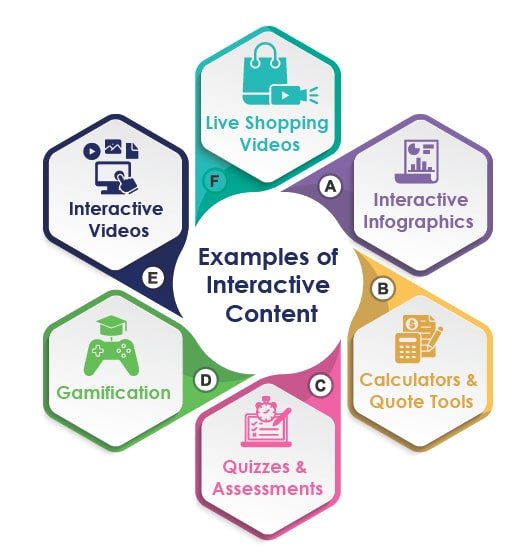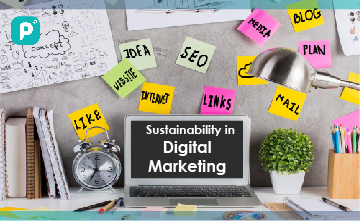“Tell me and I forget. Teach me and I remember. Involve me and I learn.” – Benjamin Franklin
In the modern era of digital technology, individuals desire more than merely consuming passive content. They seek engaging, customized experiences that cater to their distinct interests and inclinations. This is where interactive content becomes essential, presenting a lively and immersive method for marketing and engaging with customers. By allowing audiences to actively participate and shape their experiences, interactive content has emerged as a powerful tool for brands and advertisers seeking to stand out in a crowded digital landscape.
What is Interactive Content?

Interactive content is a term that encompasses any form of digital content that requires active engagement from the user, rather than passive consumption. This can include quizzes, polls, calculators, games, augmented reality (AR) experiences, and interactive videos, among others. Unlike traditional static content, such as blog posts or infographics, interactive content is designed to respond to user input and adapt to their actions, creating a more personalized and engaging experience.
The Importance of Interactive Content
There are several key reasons why interactive content has become an essential component of modern marketing strategies:

Increased Engagement and Personalization
Interactive content offers a more immersive and personalized experience for users, as they actively participate in shaping the content they consume. This level of engagement can lead to improved learning outcomes, better retention of information, and a stronger emotional connection with the brand.
Valuable Consumer Insights
By tracking user interactions and behaviours, interactive content provides valuable data and insights into consumer preferences, interests, and pain points. This information can be leveraged to refine marketing efforts, tailor product offerings, and deliver more targeted and effective campaigns.
Boosted Conversion Rates
Studies have shown that interactive content can significantly increase conversion rates compared to passive content. When users are actively engaged and invested in an experience, they are more likely to take the desired action, whether it’s making a purchase, signing up for a service, or sharing the content with others.
Fostering Creativity and Brand Differentiation
Interactive content presents an opportunity for brands to unleash their creativity and stand out from competitors. By offering unique and engaging experiences, businesses can effectively differentiate themselves and leave a lasting impression on their target audiences.
Examples of Interactive Content

Interactive Infographics
While traditional infographics are static and one-dimensional, interactive infographics encourage user engagement by incorporating elements such as clickable sections, animated visuals, and scrolling narratives. These dynamic visuals can enhance the learning experience and make complex information more digestible.
Calculators and Quote Tools
Practical and engaging, calculators and quote tools offer personalized insights and recommendations based on user inputs. For example, a mortgage calculator can provide tailored estimates based on factors like loan amount, interest rate, and desired term length.
Quizzes and Assessments
Quizzes and assessments are highly effective at capturing user attention and gathering valuable data. By presenting a series of questions or challenges, brands can gain insights into user preferences, knowledge levels, and areas of interest, while also providing an enjoyable and shareable experience.
Gamification
Incorporating game-like elements, such as point systems, leaderboards, and challenges, into non-game contexts can significantly enhance user engagement and motivation. Gamification taps into our natural desire for achievement, competition, and recognition, making it a powerful tool for driving desired behaviours and fostering brand loyalty.
Interactive Videos
Interactive videos, often referred to as “choose your own adventure” narratives, put the user in control of the storytelling experience. By allowing viewers to make decisions and explore different paths, these videos create a more personalized and memorable experience, increasing engagement and retention.
Live Shopping Videos
Live shopping videos, or live streams designed to showcase and sell products or services, have gained immense popularity in recent years. These interactive experiences allow brands to connect with their audiences in real time, answer questions, and provide personalized recommendations, creating a more engaging and transparent shopping experience.
The Role of Personalization
While interactive content is a powerful tool in its own right, its true potential is unleashed when combined with personalization strategies. By leveraging consumer data and insights gathered through interactive experiences, brands can tailor their content and messaging to specific audience segments, delivering highly relevant and personalized experiences.

According to a report by Twilio Segment, 80% of business leaders believe that consumers spend 38% more when their experience is personalized. This statistic underscores the importance of personalization in today’s consumer landscape, where choice and control are paramount.
By embracing interactive content and personalization, brands can move away from the traditional “one-size-fits-all” approach and instead offer tailored experiences that resonate with their target audiences. This not only fosters stronger customer relationships and loyalty but also contributes to increased conversions and revenue growth.
The Future of Interactive Content and Personalization

As the digital advertising landscape continues to evolve, with the deprecation of cookies and increasing concerns around consumer privacy, interactive content and personalization will play an even more crucial role. With the industry moving towards a probabilistic ecosystem, brands and advertisers will need to find new and innovative ways to engage audiences and gather valuable insights.
One solution lies in leveraging interactive creative formats, such as microsites, 3D offerings, quizzes, branded custom games, and augmented reality (AR) experiences. By encouraging user exploration and interaction, these formats not only provide an engaging and memorable experience but also offer a new layer of understanding of consumer interests and preferences.
As users interact with these interactive ad units, brands and advertisers can analyze their behaviours and optimize the overall experience accordingly. This iterative process allows for a deeper understanding of the target audience, enabling more effective campaign execution and personalization efforts.
Moreover, the rise of interactive content and personalization aligns with the broader shift towards a more consumer-centric advertising approach. Consumers increasingly expect control and flexibility over the ads they engage with, and interactive experiences provide a means for brands to meet these expectations while fostering positive brand affinity.
Conclusion
In a world where consumer attention is becoming increasingly fragmented, interactive content and personalization offer a powerful solution for brands seeking to cut through the noise and create meaningful connections with their audiences. By embracing the principles of interactivity and tailoring experiences to individual preferences, businesses can foster deeper engagement, gather valuable insights, and ultimately drive better results across the customer journey.
As the digital landscape continues to evolve, those who prioritize interactive content and personalization will be better positioned to adapt and thrive, delivering experiences that resonate with consumers on a profound level. The future of marketing lies in empowering consumers to shape their own journeys, and interactive content provides the canvas for this transformative shift.
Ready to leverage the power of digital marketing for your digital platform? Connect with us today by emailing us at [email protected].
All images belong to their respective owners. Please email [email protected] if removal is required.




